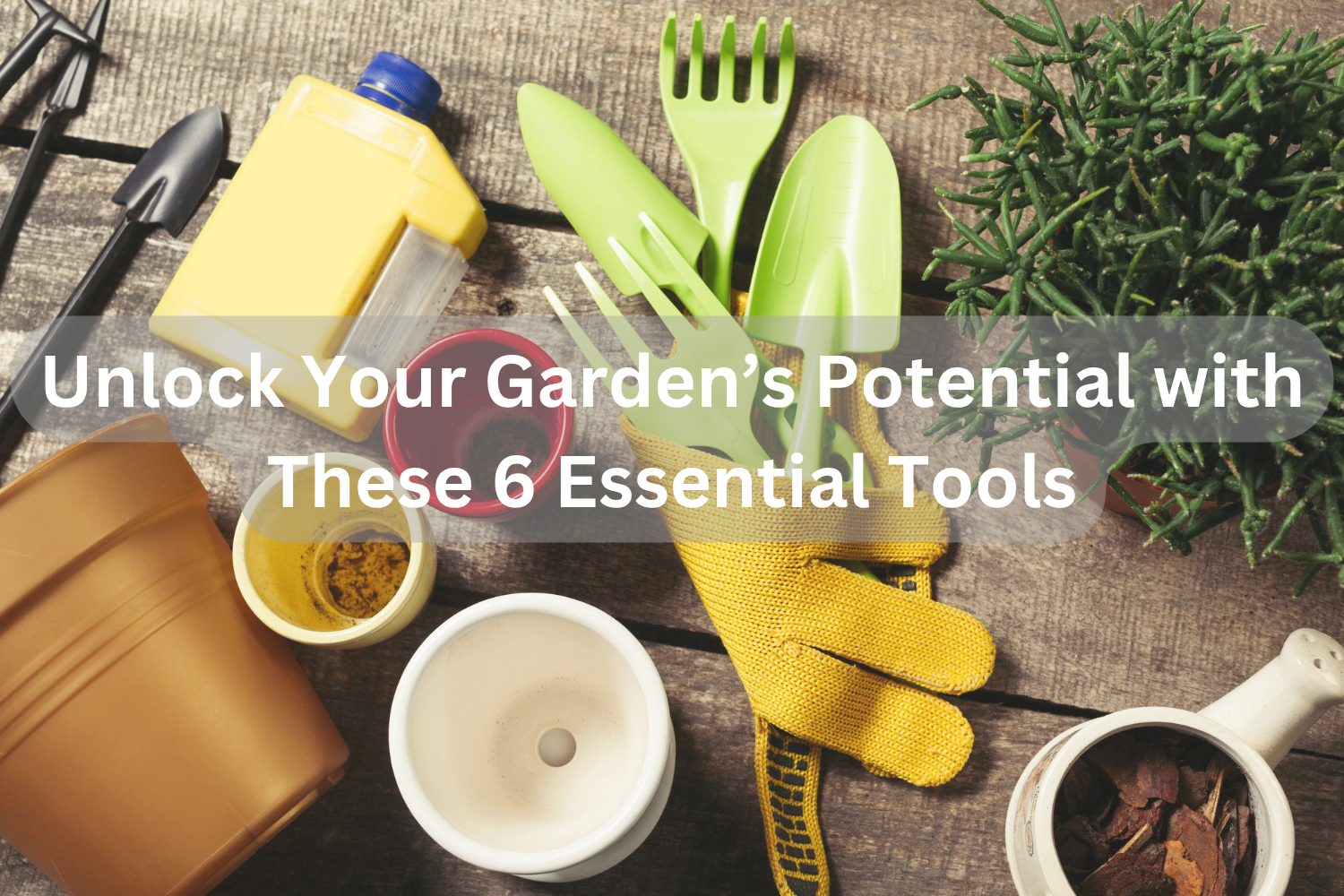Gardening is an art, a therapy and a way to raise the look of your place. If you’re an old gardener or fresh to the art, you need right tools and proper gardening tools are going to help turn your planting dreams into reality. Unlike with many other tasks, the best thing is that you don’t need an arsenal of expensive hi-tech tools: six essential tools can very well transform your garden into a thriving oasis.
To learn more about these six must have tools, we spend some time digging deeper into them here: what they are, how they are used, what benefits they can provide you with based on your gardening needs, and some suggestions for which ones would be the best for you to use.
The Hand Trowel: Your All-Purpose Companion
What is a Hand Trowel?
Hand trowel is a tiny, transportable weeding and gardening tool having a pointed, scoop formed edge, helpful for digging, planting and weeding. Versatility and ease of use make it a basic essential tool for any gardener.
Why Do You Need It?
A hand trowel is one of the most frequently used tools in any garden. Here’s why:
- Planting: Whether you’re planting flowers, vegetables, or shrubs, a hand trowel allows you to dig holes with precision. You can control the size of the hole and the depth, which is essential for the health of your plants.
- Weeding: Small weeds can be tricky to remove, but a hand trowel allows you to dig them out easily, roots and all, preventing them from growing back quickly.
- Soil Mixing: A hand trowel can also be used for mixing soil, compost, or fertilizers in smaller garden beds. It helps break up clumps and ensures that the amendments are evenly distributed.
Choosing the Right Hand Trowel
When purchasing a hand trowel, the materials the handle is made of (wood, plastic, or metal) the length of the blade, and how ergonomic it is are things you should take into consideration. A comfortable grip will also help you with gardening that lasts longer than usual on your hands.
The Garden Hoe: Essential for Weeding and Soil Prep
What is a Garden Hoe?
A garden hoe is one long pole with a flat blade, angled for cutting and scraping the soil and used only with one hand. Larger garden beds are usually cultivated with hoe, and used to remove weeds.
Why Do You Need It?
The garden hoe is indispensable for large-scale weeding and soil preparation. It’s especially useful for:
- Weeding: A hoe allows you to slice through the soil and chop off weeds at the root level, making it easier to clear out unwanted plants before they take over your garden.
- Soil Aeration: Loosening the soil with a hoe ensures that the earth is aerated, helping water, air, and nutrients reach plant roots.
- Garden Bed Preparation: If you’re preparing a new garden bed or reshaping an existing one, a hoe will help you break up compacted soil and create a smooth, level surface for planting.
Choosing the Right Garden Hoe
There are different types of hoes, such as the oscillating hoe (which moves back and forth), the stirrup hoe (with a thin blade), and the traditional flat hoe. Choose a hoe based on the size of your garden and the tasks you need it for. A wider blade is ideal for larger areas, while a smaller, more precise hoe works well for tighter spaces.
The Pruning Shears: For Perfectly Trimmed Plants
What Are Pruning Shears?
Secatious are known as small, sharp scissors used for cutting plants. Equipped with spring loaded mechanism for more precise and controlled cuts, and are in different size to meet different gardening needs.
Why Do You Need Them?
Pruning is crucial for maintaining plant health and encouraging growth, and a good pair of pruning shears makes the job much easier. Here’s why pruning shears are a must-have:
- Promoting Healthy Growth: Regular pruning removes dead or diseased wood, which can prevent diseases from spreading to healthy parts of the plant. This ensures that your plants grow strong and vibrant.
- Shaping Plants: Pruning shears allow you to shape plants to your desired size and form. Whether you’re trimming bushes or topiary, they provide clean cuts that promote new growth.
- Deadheading Flowers: Removing spent flowers is essential for encouraging plants to produce new blooms. Pruning shears are ideal for snipping off wilting flowers to make room for fresh ones.
Choosing the Right Pruning Shears
When choosing pruning shears make sure the blades are of high quality steel so that they stay sharp and durable. Tasks that need to be done with precision also need an easy to hold grip. Bypass shears do not cut in a direct, degenerating fashion like anvil shears, so they’re preferable for live plants and anvil shears work best for dead wood.
The Watering Can: For Proper Plant Hydration
What is a Watering Can?
A watering can is a container designed to hold and dispense water for your plants. It typically features a long spout and a handle for easy carrying and pouring.
Why Do You Need It?
Watering is essential to keeping your plants healthy, and a watering can gives you control over the amount and direction of water. Here’s how a watering can benefits your garden:
- Precise Watering: The long spout of a watering can allows you to direct water precisely to the base of your plants, ensuring that the roots get the moisture they need without wetting the foliage.
- Easy to Handle: Unlike a hose, which can be heavy and difficult to manage in tight spaces, a watering can is lightweight and portable, making it ideal for small or container gardens.
- Gentle Watering: A watering can’s nozzle can be adjusted to deliver water gently, making it the perfect tool for fragile plants that may be damaged by strong water pressure.
Choosing the Right Watering Can
Choose a watering can with an ergonomic handle that fits comfortably in your hand. Look for one with a detachable spout or a fine rose (the nozzle) for an even distribution of water. The size of the can should depend on the size of your garden; larger cans hold more water, reducing trips to the tap.
The Rake: For Perfectly Groomed Garden Beds
What is a Garden Rake?
A garden rake is a tool with a long handle and a wide, flat head with multiple tines (prongs). It’s used to level soil, gather debris, and spread mulch or compost evenly.
Why Do You Need It?
A garden rake is essential for maintaining a tidy and organized garden. Here’s how it helps:
- Clearing Leaves and Debris: A rake is perfect for gathering fallen leaves, twigs, and other debris from your garden beds and lawns.
- Leveling Soil: If you’ve recently tilled or dug up a garden bed, a rake will help you level the soil, ensuring an even surface for planting.
- Spreading Mulch and Compost: After applying compost or mulch to your garden, a rake can help distribute it evenly across your soil, ensuring the benefits are spread throughout the bed.
Choosing the Right Garden Rake
Garden rakes come in different sizes and designs. Choose one with durable, rust-resistant tines, especially if you’re working in heavy soil. A wider rake is suitable for larger garden areas, while a narrower rake works well for tight spaces or raised beds.
The Garden Fork: For Digging and Aerating Soil
What is a Garden Fork?
A garden fork is a hand tool with several strong, pointed tines, ideal for digging, aerating soil, and turning compost. It’s an essential tool for more intensive tasks in the garden.
Why Do You Need It?
Garden forks are perfect for tasks that require more force than a hand trowel can provide:
- Digging: If you need to dig deeper into the soil, whether for planting larger plants or removing stubborn roots, a garden fork is much more effective than a trowel.
- Aerating the Soil: Aeration is key to improving soil structure, especially in clay-heavy or compacted soil. A garden fork helps loosen the soil, allowing air, water, and nutrients to reach the roots more effectively.
- Turning Compost: A garden fork is ideal for mixing compost, as its tines allow you to lift and turn the material easily, promoting decomposition.
Choosing the Right Garden Fork
Examine the handle of a garden fork keenly for a sturdy, ergonomic handle which is easy on the grip. Durable and rust resistant stainless steel or carbon steel tines. A fork with four to six tines will suit most gardening tasks and depending on your needs.
Conclusion: Unlocking Your Garden’s Potential
The right tools for your garden reflect the care and attention that you put towards it. There are six must have tools for your beautiful garden: hand trowels, garden hoes, pruning shears, watering cans, garden rakes, and garden forks. Namely, you’ll be given these tools to help you with everything from planting and weeding to pruning and watering.
There’s no gardening final destination; it’s a journey. However with the right tools and a bit of patience you’ll be enjoying that same sense of joy and reward from your garden.
Frequently Asked Questions
Q: What are the most important gardening tools for beginners?
A: For beginners, a hand trowel, garden hoe, pruning shears, and watering can are the most essential tools. These will allow you to perform basic tasks like planting, weeding, trimming, and watering.
Q: How often should I prune my plants?
A: Most plants benefit from pruning once a year, either in early spring or late fall. However, some plants, like roses or perennials, may require more frequent trimming to encourage new growth or remove dead flowers.
Q: Can I use a garden rake for picking up leaves?
A: Yes, a garden rake is perfect for gathering leaves and other debris. Its wide head allows you to cover more area quickly and efficiently.
Q: How do I maintain my gardening tools?
A: To keep your tools in top shape, clean them after each use to remove dirt and sap. Sharpen blades regularly and store tools in a dry, cool place to prevent rust. Oiling wooden handles can also help maintain their condition.
Q: What’s the best way to water my plants?
A: Water your plants deeply and consistently. Use a watering can for smaller plants or containers, and make sure to water the base of the plant rather than the leaves to avoid disease.





